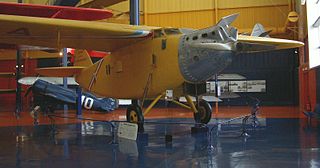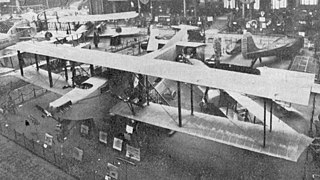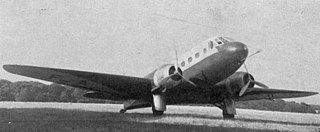
The Ilyushin Il-18 is a large turboprop airliner that first flew in 1957 and became one of the best known and most durable Soviet aircraft of its era. The Il-18 was one of the world's principal airliners for several decades and was widely exported. Due to the aircraft's airframe durability, many examples achieved over 45,000 flight hours and the type remains operational in both military and civilian capacities. The Il-18's successor was the long range Il-62 jet airliner.

The de Havilland DH.87 Hornet Moth is a single-engined cabin biplane designed by the de Havilland Aircraft Company in 1934 as a potential replacement for its highly successful de Havilland Tiger Moth trainer. Although its side-by-side two-seat cabin made it closer in configuration to the modern aircraft that military trainee pilots would later fly, there was no interest from the RAF and the aircraft was put into production for private buyers.
The Aero A.204 was a Czechoslovakian airliner that flew in prototype form in 1936. It was developed specifically for ČSA, but much to Aero's surprise and disappointment, the national airline selected a British product instead, the Airspeed Envoy. Unable to find a customer, Aero began to develop a military version instead, as the A.304.

The Farman F.220 and its derivatives were thick-sectioned, high-winged, four engined monoplanes from Farman Aviation Works. Based on the push-pull configuration proven by the F.211, design started in August 1925 and the first flight of the prototype was on 26 May 1932. The definitive F.222 variant was the biggest bomber to serve in France between the world wars. One variant was designed as an airliner.

The Beriev Be-30 is a Russian regional airliner and utility transport aircraft designed by the Beriev Design Bureau. It was developed specifically for Aeroflot local service routes using short, grass airstrips. It was also designed to be used in the light transport, aerial survey and air ambulance roles. It competed against the Antonov An-28 and the Czechoslovakian LET-410.

The PZL.44 Wicher (gale) was a prototype of 14-seat, twin-engine Polish airliner, built in the Państwowe Zakłady Lotnicze (PZL) in 1938. It was to compete with the DC-2 and Lockheed Super Electra.

The Avro 552 was a British light biplane aircraft produced in the early 1920s. It was another attempt by Avro to sell a derivative of the wartime 504 to the civil market.

The Bernard 190 or Bernard-Hubert 190 was a French airliner of 1928. It was a high-wing cantilever monoplane of conventional configuration, based on the Bernard 18. Compared with its predecessor, it kept the same basic design but featured redesigned tail surfaces, an enlarged cabin, and offered its flight crew a completely enclosed cockpit. Also like its predecessor, the basic airliner model provided the basis for a long-range aircraft to be used in record attempts, the 191GR.

The Caudron C.61 was a French three-engined civil transport biplane aircraft built by the French aeroplane manufacturer Caudron. It was constructed of wood and covered in fabric.

The Farman F.170 Jabiru was a 1925 single-engine airliner evolved from the F.121 Jabiru, built by the Farman Aviation Works.

The Farman F.180 Oiseau Bleu was a 1920s French biplane airliner. The F.180 was designed to fly non-stop between Paris and New York, but when the crossing attempt was cancelled three aircraft were built as luxury transports to operate from Paris to nearby European capital cities for the company's own airline.

The Fairchild 91,, was a single-engine eight-passenger flying boat airliner developed in the United States in the mid-1930s.

The Farman F.160 was a heavy bomber aircraft developed in France in the late 1920s. It was essentially an attempt by Farman Aviation Works to modernise its tremendously successful F.60 Goliath design of the immediately postwar years. The most noticeable external difference was the larger tailfin of the new aircraft. Like its predecessor, it was a large three-bay biplane of conventional configuration with unstaggered wings of equal span. Initially conceived as a heavy night bomber, most examples built were float-equipped torpedo bombers for the Aéronautique Maritime, which operated some 40 of the F.165 variant and 200 of the F.168. One of the original F.160 night bombers was exported to Italy, and one to Japan. Plans to develop airliner versions did not progress past the prototype stage.

The Renard R.35 was a prototype pressurised airliner of the 1930s built by the Belgian aircraft manufacturer Constructions Aéronautiques G. Renard. A three-engined low-winged monoplane with retractable undercarriage, the R.35 was destroyed in a crash on its first flight.
The Jurca MJ-53 Autan is a plans-built, low-wing, touring monoplane designed in France by Marcel Jurca.

The Bernard 82 was a French single-engined long-range monoplane bomber designed and built by Société des Avions Bernard. Only two prototypes were built and the type did not enter production.
The Farman F.420 was a twin engine monoplane, built in France in the mid-1930s to compete in a government contest for an aircraft capable of fulfilling bomber, fighter and reconnaissance roles. Two prototypes were constructed but no production followed.
The Bernard 80 GR was one of three types built by different French constructors in response to a government call for an aircraft capable of setting new long-distance records. A single engine monoplane with a crew of two, the 80 GR set an absolute record for flight over a closed circuit in April 1931, covering 8,960 km (5,569 mi). Modifications led to a new designation as the Bernard 81 GR but no more records were set despite several attempts.

The Caudron C.74 was a ten-seat, four engine passenger biplane built in France in 1922. It showed promise but the sole prototype crashed fatally in a competition and no more were completed.

The Bréguet 670, Bréguet 670T or Bréguet-Wibault 670 was a French twin engine, all metal eighteen seat airliner with a retractable undercarriage flown in 1935. Only one was built.

















